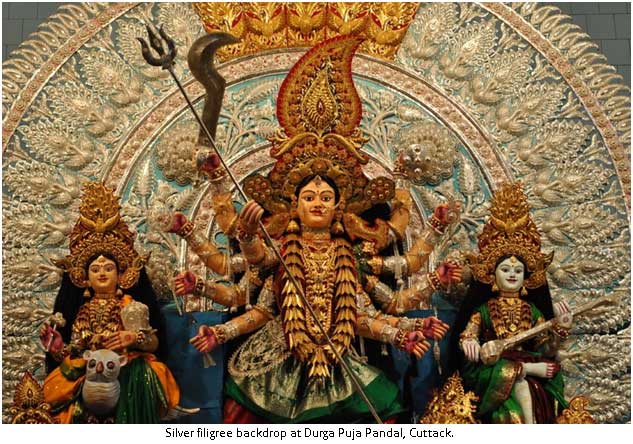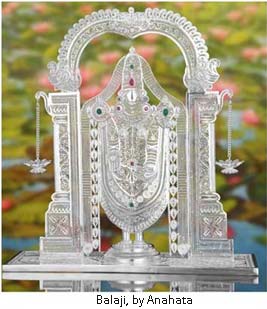&
Depleting Craftsman Count
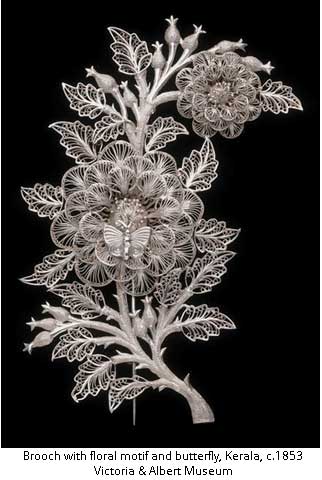 ‘To harness a silvery moonbeam and weave it into a delicate lace of intricate patterns’ – comes close to describing the beauty of a filigree artifact. Created with only the purest silver or gold, the magician is the craftsman, whose nimble fingers, guided by his heritage handed down father to son, brings to life ethereal creations coveted by the kings and nobility.
‘To harness a silvery moonbeam and weave it into a delicate lace of intricate patterns’ – comes close to describing the beauty of a filigree artifact. Created with only the purest silver or gold, the magician is the craftsman, whose nimble fingers, guided by his heritage handed down father to son, brings to life ethereal creations coveted by the kings and nobility.
Indian’s wealth lies in its rich heritage of crafts that rests in the hands of the few who inherited the secrets and techniques whispered into their ears even before they left the cradle.
ANTIQUITY
Historians have attributed the advancement and mastery of the filigree craft to Egyptians, Greeks and Etruscans around 6 BC to 3 BC. In Mesopotamia, filigree workmanship in silver and gold, is prevalent to day and their ‘Telkari’ jewellery is known for its delicate designs.
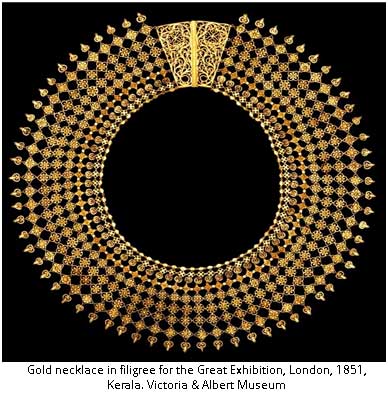 However, archaeologists have dug up interesting evidence of a highly evolved filigree making technique dating 2 BC to 2 AD, from Peddabunkur, Kotlingala, Dhulikata and Kondapur in Andhra Pradesh. Over the years, outside influences played into the designs. The Portuguese, who produce fine filigree objects d’ art, may have swapped ideas, and exchanged influences with the Karimnagar craftsmen. The silver filigree work of Cuttack in Orissa is known as ‘Tarakashi’, and shares similarities with Indonesian silver art. The early trade links between the regions could have led to the swap in ideas. South Indonesia’s Kandari Filigree is likely to have been influenced by the Arab, Persian and Indian traders sailing into the ports. It’s a round world.
However, archaeologists have dug up interesting evidence of a highly evolved filigree making technique dating 2 BC to 2 AD, from Peddabunkur, Kotlingala, Dhulikata and Kondapur in Andhra Pradesh. Over the years, outside influences played into the designs. The Portuguese, who produce fine filigree objects d’ art, may have swapped ideas, and exchanged influences with the Karimnagar craftsmen. The silver filigree work of Cuttack in Orissa is known as ‘Tarakashi’, and shares similarities with Indonesian silver art. The early trade links between the regions could have led to the swap in ideas. South Indonesia’s Kandari Filigree is likely to have been influenced by the Arab, Persian and Indian traders sailing into the ports. It’s a round world.
PROCESS
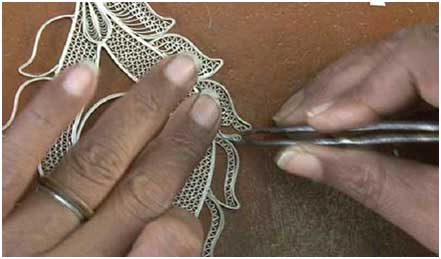 In the pre-mechanisation era, the production process relied on manually beating silver ingots, drawing out thin wires of different thickness by a long process. The hair-like fine wires are still drawn out by this method. It’s a complex technique, where wires are wound, heated, flattened, bent, crimped and combined with other components to create delicate filigree. Indeed, it would be appropriate to say that filigree is the ultimate showcase of the skill of human hands. Besides jewellery, objects like boxes, bowls, perfume holders, trays, plates, idols of deities, replicas of popular local monuments like Konark Temple, Char Minar, Taj Mahal, animal or bird figures are some of the range created. Bespoke luxury designers like Anahata have added more innovations to the design range. Anahata’s wedding gift range, home decor pieces, spiritual artefacts, corporate gifts, are all as much a part of their heirloom collection with their excellent craftsmanship, indicative of how a craftsman with the right patronage, can yet raise the bar on the beauty and finesse of his craft.
In the pre-mechanisation era, the production process relied on manually beating silver ingots, drawing out thin wires of different thickness by a long process. The hair-like fine wires are still drawn out by this method. It’s a complex technique, where wires are wound, heated, flattened, bent, crimped and combined with other components to create delicate filigree. Indeed, it would be appropriate to say that filigree is the ultimate showcase of the skill of human hands. Besides jewellery, objects like boxes, bowls, perfume holders, trays, plates, idols of deities, replicas of popular local monuments like Konark Temple, Char Minar, Taj Mahal, animal or bird figures are some of the range created. Bespoke luxury designers like Anahata have added more innovations to the design range. Anahata’s wedding gift range, home decor pieces, spiritual artefacts, corporate gifts, are all as much a part of their heirloom collection with their excellent craftsmanship, indicative of how a craftsman with the right patronage, can yet raise the bar on the beauty and finesse of his craft.
EVOLUTION AND PATRONAGE
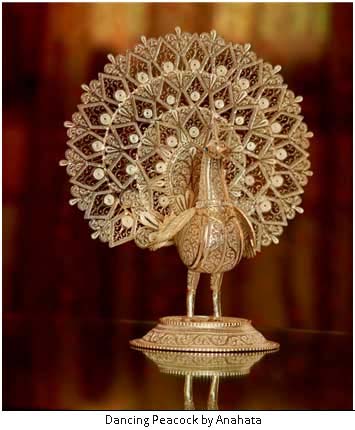 Silver filigree has been produced in several regions of India, such as in Orissa, Karimnagar in Andhra Pradesh Srinagar in Kashmir, Jhansi in Uttar Pradesh, Trivandrum in Kerala, as well as in certain parts of Tripura, Rajasthan and West Bengal. Over time, the filigree craftsmen from India’s southern and eastern regions of the country have kept alive the traditions.
Silver filigree has been produced in several regions of India, such as in Orissa, Karimnagar in Andhra Pradesh Srinagar in Kashmir, Jhansi in Uttar Pradesh, Trivandrum in Kerala, as well as in certain parts of Tripura, Rajasthan and West Bengal. Over time, the filigree craftsmen from India’s southern and eastern regions of the country have kept alive the traditions.
In the South, the filigree craftsmen, primarily goldsmiths and silversmiths, enjoyed the patronage of the Nizam of Hyderabad and the nobility of the region. The gifting of beautiful silver or gold filigree artwork at weddings became a part of the tradition. Nawab Mir Yusuf Ali Khan Salar Jung III, a connoisseur and collector who lived to acquire objects of beauty and rarity from across the globe, added several filigree objects to his collection. Yet on display at the Salar Jung Museum is a Rose Water Sprinkler, Ganga Jamni trays with betel leaf and lotus leaf patterns, a cigar case, all from the 19th Century, along with spice box, paandans or betel box.
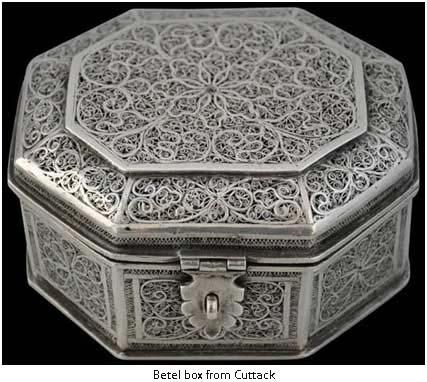
In the Eastern part of India, the Silver filigree work from Cuttack in Orissa is known as ‘Tarakashi’, which literally translates as ‘tightened wire’. It is famed for its spider’s web like patterns, with the rose motif dominant. There is a marked influence from the artistic sensibilities of the Mughal and Persian patterns. As in Karimnagar, it was in the mid-nineteenth century that the craft reached its peak.
Cuttack’s filigree district is a major tourist attraction. In current times, the silversmiths craft elaborate backdrops in Tarakashi to adorn the deity during Durga Puja. This draws huge tourist crowds.
THE PLIGHT of the CRAFTSMAN
The loss of royal patronage hugely hit the filigree trade, and thereby the craftsman communities. The rising cost of silver affected its appeal to the middle-class, who had lifted sales for a while in the Sixties. As a result the families of craftsman communities have depleted significantly, opting for other professions. Aged craftsman, who have lost the dexterity of their hands and are unable to create, have been reduced to penury. Their children have resorted to manual jobs like auto-rickshaw drivers. Even the artisans who have won prestigious government awards are struggling for their survival.
In Cuttack, the filigree artisans took the initiative and have become associated with the Durga Puja pandals, decorating it with ‘Tarakashi’ jewellery tableaux. This gives employment to nearly 150 artisans each year during the Puja. More than 500 kgs of silver is used to create the decorations. Mrs Ragini Kiran Grandhi has launched Anahata Creations, to market and popularise the filigree craft and generate a livelihood for the craftsman.
Interest from luxury designers and collectors can give filigree craftsman a new lease of life.

